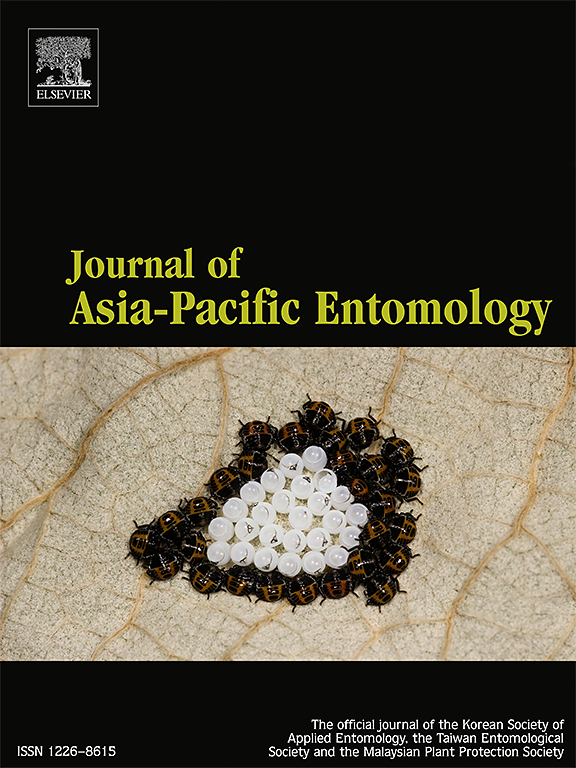Efficacy of azithromycin in alternative chemical management of the fruit fly Drosophila melanogaster (Meigen) (Diptera: Drosophilidae) reared on an artificial diet
IF 1.1
3区 农林科学
Q3 ENTOMOLOGY
引用次数: 0
Abstract
This study evaluated the macrolide antibiotic azithromycin (AZR) as an alternative chemical for managing the model pest fruit fly Drosophila melanogaster (Meigen) (Diptera: Drosophilidae). The effects of AZR on survival rate, developmental time, adult longevity and larval cytochrome P450 monooxygenase (CYP450) activity of D. melanogaster were assessed at dietary concentrations of 100, 200, 400 and 800 mg/L. Dietary AZR significantly reduced survival at all developmental stages. At the highest concentration (800 mg/L), AZR significantly reduced adult emergence from 87.00 ± 3.35 to 6.00 ± 1.00 % (χ2 = 112.511; d.f. = 1; P < 0.05) and increased developmental time to adulthood from 8.44 ± 0.12 to 9.87 ± 0.36 days (F = 3.566; d.f. = 4, 15; P < 0.05). Adult longevity was sharply reduced from 22.63 ± 0.68 to 2.75 ± 0.12 days (F = 172.020; d.f. = 4, 15; P < 0.05). However, AZR at 200–400 mg/L did not lead to a significant increase developmental time. In addition to decreased survival and prolonged developmental time in the 3rd instar, the highest AZR concentration significantly increased CYP450 enzyme activity in the larvae by approximately 7-fold (F = 795.256; df = 4, 15; P < 0.05). These findings suggest that antibiotic-based dietary formulation serve as promising alternative chemical management strategies for pest fruit flies, such as Drosophila suzukii (Matsumura) (Diptera: Drosophilidae), as part of an integrated pest management program.

阿奇霉素对人工饲养的黑腹果蝇(双翅目:果蝇科)替代化学管理的效果
本研究评价了大环内酯类抗生素阿奇霉素(AZR)作为防治模式害虫黑腹果蝇(双翅目:果蝇科)的替代化学药剂。研究了饲粮浓度分别为100、200、400和800 mg/L的AZR对黑腹天鼠成虫存活率、发育时间、成虫寿命和幼虫细胞色素P450单加氧酶(CYP450)活性的影响。饲粮中AZR显著降低了各发育阶段的存活率。在最高浓度(800 mg/L)下,AZR显著降低成虫羽化率,从87.00±3.35 %降至6.00±1.00 % (χ2 = 112.511;d.f. = 1;P & lt;发育时间从8.44±0.12天增加到9.87±0.36天(F = 3.566;D.f = 4,15;P & lt;0.05)。成虫寿命由22.63±0.68天锐减至2.75±0.12天(F = 172.020;D.f = 4,15;P & lt;0.05)。而200 ~ 400 mg/L的AZR对发育时间无显著影响。最高浓度的AZR除降低了3龄幼虫的存活率和延长了其发育时间外,还使其CYP450酶活性显著提高了约7倍(F = 795.256;Df = 4,15;P & lt;0.05)。这些发现表明,以抗生素为基础的膳食配方作为害虫果蝇的替代化学管理策略,如铃木果蝇(双翅目:果蝇科),作为害虫综合管理计划的一部分。
本文章由计算机程序翻译,如有差异,请以英文原文为准。
求助全文
约1分钟内获得全文
求助全文
来源期刊

Journal of Asia-pacific Entomology
Agricultural and Biological Sciences-Insect Science
CiteScore
2.70
自引率
6.70%
发文量
152
审稿时长
69 days
期刊介绍:
The journal publishes original research papers, review articles and short communications in the basic and applied area concerning insects, mites or other arthropods and nematodes of economic importance in agriculture, forestry, industry, human and animal health, and natural resource and environment management, and is the official journal of the Korean Society of Applied Entomology and the Taiwan Entomological Society.
 求助内容:
求助内容: 应助结果提醒方式:
应助结果提醒方式:


